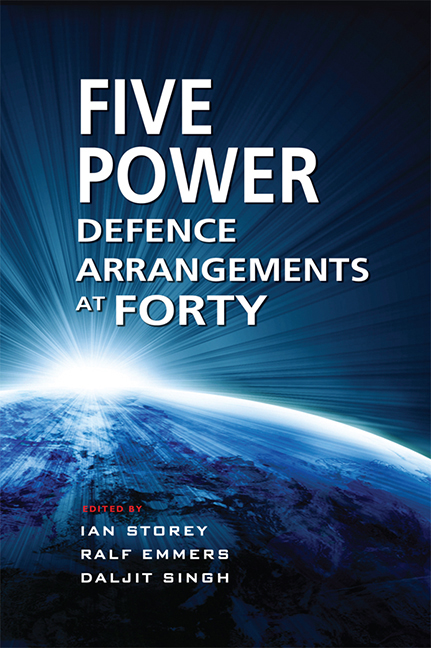Book contents
- Frontmatter
- Contents
- Contributors
- Foreword
- Glossary
- Introduction
- 1 A Little Ray of Sunshine: Britain, and the Origins of the FPDA – A Retrospective on Objectives, Problems and Solutions
- 2 On the Establishment of the Five Power Defence Arrangements
- 3 Malaysian Foreign Policy and the Five Power Defence Arrangements
- 4 The Five Power Defence Arrangements Exercises, 2004–10
- 5 The FPDA's Contribution to Regional Security: The Maritime Dimension
- 6 An FPDA Role in Humanitarian Assistance and Disaster Relief?: It's More than Just the Armed Forces
- 7 A Quasi-Pact of Enduring Value: A Malaysian Perspective of the FPDA
- 8 The FPDA and Asia's Changing Strategic Environment: A View from New Zealand
- 9 The Future of the FPDA in an Evolving Regional Strategic Environment
- Index
6 - An FPDA Role in Humanitarian Assistance and Disaster Relief?: It's More than Just the Armed Forces
Published online by Cambridge University Press: 21 October 2015
- Frontmatter
- Contents
- Contributors
- Foreword
- Glossary
- Introduction
- 1 A Little Ray of Sunshine: Britain, and the Origins of the FPDA – A Retrospective on Objectives, Problems and Solutions
- 2 On the Establishment of the Five Power Defence Arrangements
- 3 Malaysian Foreign Policy and the Five Power Defence Arrangements
- 4 The Five Power Defence Arrangements Exercises, 2004–10
- 5 The FPDA's Contribution to Regional Security: The Maritime Dimension
- 6 An FPDA Role in Humanitarian Assistance and Disaster Relief?: It's More than Just the Armed Forces
- 7 A Quasi-Pact of Enduring Value: A Malaysian Perspective of the FPDA
- 8 The FPDA and Asia's Changing Strategic Environment: A View from New Zealand
- 9 The Future of the FPDA in an Evolving Regional Strategic Environment
- Index
Summary
The role of armed forces in Humanitarian Assistance and Disaster Relief (HA/DR) is highly relevant for several reasons. The first is due to the increasing salience of HA/DR issues in the Asia Pacific, especially given the extreme propensity the region has for natural disasters and the extent of urban agglomerations, both of which mean that the scale of disaster is likely to be large and to require all available resources to respond. Given this, it makes sense for regional armed forces to examine how they can contribute effectively when called upon. The second reason, directly relevant to the Five Power Defence Arrangements (FPDA), is because FPDA ministers have called for an examination of the issue and its applicability for the armed forces of member states. The call is not surprising given the first point and the fact that the FPDA as an institution has always been prepared to evolve to meet the needs of a changing geopolitical and operational environment.
In examining HA/DR issues, the FPDA is following a now relatively common line which sees ever more consideration of the use of armed forces in non-traditional, non-war fighting roles. In 2008, the Stockholm International Peace Research Institute (SIPRI) published a study of the effectiveness of the armed forces in disaster response. Two years later the UK-based international conference centre Wilton Park ran a disaster management conference with a session dealing with the role of armed forces in disaster risk reduction, (an HA/DR issue). Both the ASEAN Regional Forum and the ASEAN Defence Ministers' Meeting Plus (ADMM- Plus) have begun to consider how HA/DR issues might be incorporated into military activities and capabilities, and the Western Pacific Naval Symposium devoted its 2011 session to HA/DR issues. Nonetheless, merely because the issue is salient is not in itself a sufficient reason for the FPDA to undertake tasks in this area; it is though a reason for a more systematic examination of the relevant factors.
- Type
- Chapter
- Information
- The Five Power Defence Arrangements at Forty , pp. 85 - 97Publisher: ISEAS–Yusof Ishak InstitutePrint publication year: 2011

